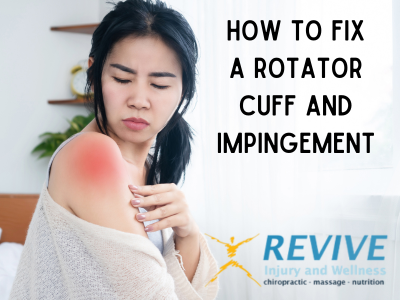
The rotator cuff is a group of muscles and tendons in the shoulder that plays a crucial role in shoulder stability and mobility. When the rotator cuff becomes injured or inflamed, it can lead to pain, weakness, and limited range of motion—a condition known as rotator cuff impingement.
Understanding Rotator Cuff Impingement
Rotator cuff impingement occurs when the tendons of the rotator cuff muscles become irritated or inflamed as they pass through the narrow space between the top of the upper arm bone (humerus) and the acromion, a bone in the shoulder blade (scapula). This can happen due to various reasons, including overuse, repetitive overhead motions, aging, or trauma.
Common Symptoms of Rotator Cuff Impingement:
1. Shoulder pain: Typically felt on the front or side of the shoulder, which can worsen with overhead activities.
2. Weakness: Reduced strength in the shoulder, making it challenging to lift objects or perform certain movements.
3. Limited range of motion: Difficulty in raising the arm or rotating it, especially when reaching overhead or behind the back.
4. Pain at night: Discomfort or pain, often interfering with sleep.
Fixing Rotator Cuff Impingement:
1. Rest and Activity Modification: Begin by resting the affected shoulder and avoiding activities that worsen the pain. Modify your daily routines to minimize overhead motions and heavy lifting.
2. Ice and Heat: Applying ice to the affected area can help reduce inflammation and relieve pain. After the initial acute phase, consider using heat to relax muscles and improve blood flow.
3. Physical Therapy: A physical therapist can develop a tailored exercise program to strengthen the rotator cuff muscles and improve shoulder mobility. These exercises focus on improving posture, muscle balance, and overall shoulder stability.
4. Anti-Inflammatory Medications: Over-the-counter nonsteroidal anti-inflammatory drugs (NSAIDs) can help reduce pain and inflammation. Consult a healthcare professional before using any medications.
5. Corticosteroid Injections: In some cases, a healthcare provider may recommend corticosteroid injections to reduce inflammation and alleviate pain. These injections are administered directly into the shoulder joint.
6. Ultrasound-Guided Percutaneous Needle Tenotomy: This minimally invasive procedure involves using ultrasound guidance to remove damaged tissue from the rotator cuff tendons. It can be an option for cases that do not respond to conservative treatments.
7. Surgery: If conservative treatments do not provide relief, surgical options may be considered. Common surgical procedures include arthroscopy to remove impinging structures, repair of the torn rotator cuff, or decompression of the subacromial space.
Prevention and Rehabilitation:
Preventing rotator cuff impingement is essential for maintaining shoulder health. Here are some tips:
1. Maintain Good Posture: Proper posture helps distribute the load evenly on the shoulder joint.
2. Strengthen Shoulder Muscles: Regularly engage in exercises that strengthen the rotator cuff and surrounding muscles.
3. Warm-Up and Stretch: Before engaging in physical activities, warm up and stretch to prepare the shoulder muscles.
4. Proper Technique: Use proper techniques when lifting or performing overhead movements to reduce the risk of injury.
Rotator cuff impingement can be a painful and limiting condition, but with the right approach, it can be effectively managed and even resolved. If you experience persistent shoulder pain or suspect rotator cuff impingement, it’s crucial to consult a healthcare professional for a thorough evaluation and personalized treatment plan. By following these tips and working closely with a healthcare provider or physical therapist, you can regain strength, mobility, and a pain-free shoulder.
More on Our Services
Ergonomics, Posture and Chiropractic Health
5 Questions to Ask Your Chiropractor About Neck Pain
How to Choose the Right Chiropractor


